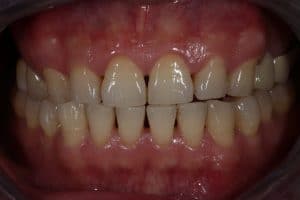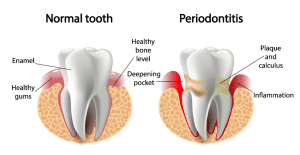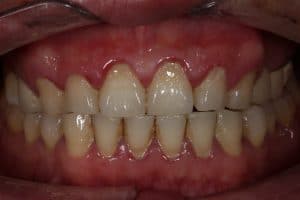What is Periodontitis?
So most of us have heard about gum disease or gingivitis, but what is periodontal disease or periodontitis?
Periodontal disease is the inflammation of the periodontal tissues that support the teeth including the gums, periodontal ligament and the alveolar bone.
Periodontal disease is caused by the bacteria that are present in plaque. If plaque is left on the teeth undisturbed for several days it can harden and turn into what we call calculus. A combination of plaque and calculus is left on the tooth surface can cause the gums to swell and start to bleed. This is the beginning of gum disease which is a precursor to periodontal disease and if left untreated it can eventually lead to tooth loss. In most cases, periodontal disease is a preventable disease.
The bacteria in plaque can spread down the root of the tooth causing destruction as it goes. It starts by causing the gums to detach from the surface of the tooth causing something called a “periodontal pocket”.
In perfect health, everyone has a natural space between their tooth and gum that averages between 1-3mm in depth. Once the bacteria has started to attack this attachment, pockets can become significantly deeper and thus, harbour more damaging bacteria.
The next stage is when the bacteria start to attack the alveolar bone which holds the teeth in place. Once this happens the teeth can become loose and could potentially fall out or need to be extracted by a dentist.
Other contributing factors can include smoking and medical conditions such as diabetes; for this reason, you will be asked to fill out a thorough dental and medical history (which is confidential) to determine if you have any predisposing risk factors for periodontal disease and to help determine which the best course of treatment for you is.
Signs of Periodontal Disease
- Swollen, red, bleeding gums that can also be painful
- Significant gum recession
- Loose teeth/ loss of teeth
- Teeth that have moved or drifted – commonly seen between front teeth

Dental 359 patient after one visit to our Hygiene Department
When you visit our clinic for your examination and preventative maintenance clean your teeth and gums will be examined for any signs of gum disease and periodontal disease. Our hygienist will assess your oral hygiene looking for any areas of plaque or calculus build-up, screen your gums for any changes in colour, shape, size and for the presence of any periodontal pockets. X-rays may also be used to determine if there is any bone loss and how much has occurred.
Preventing Periodontal Disease
- Excellent oral hygiene habits include brushing your teeth twice daily and cleaning between teeth with floss or interdental brushes at least once daily
- Consider quitting smoking to improve periodontal disease
- Professional teeth cleaning
- Regular visits for an examination and routine plaque and calculus removal
- Being aware of your own oral health and letting our hygienist know if you have noticed any bleeding coming from your gums
- Living a healthy lifestyle i.e. eating a balanced diet with lots of fruit and vegetables and partaking in regular exercise
Periodontal Disease cannot be reversed but it can be stabilised to prevent further deterioration of the dental tissues; treatment for the disease varies depending on the severity of the case. Initially, a periodontal chart may be required to measure any periodontal pockets which are followed by 1-2 visits for scaling (cleaning the teeth and gums). In most cases, you will see our dental hygienist for periodontal treatment but in severe cases, you may require a referral for more specialist care with a periodontist. Regardless of the severity or management of your disease, the most important role in your treatment is carried out by you. Excellent oral hygiene is vital in the treatment of periodontal disease and our hygienist will tailor an oral hygiene plan to suit your individual needs.
Treatment of Periodontal Disease
- Usually requires 1-2 visits but can require up to 4 visits in more severe cases
- Scaling of teeth: removal of plaque/ calculus from the tooth surface, above and slightly below the gum line
- Deeper scaling of teeth (root surface debridement ): removal of calculus from the below the gum line in the presence of periodontal pockets; in some cases this can require the use of a local anaesthetic
- Tailored oral hygiene instruction that must be followed vigilantly at home
- Replacement of any defective fillings- any rough or overhanging surfaces can contribute to the presence and progression of gum disease
- Smoking cessation advice
- Regular review appointments at 3-6 monthly intervals and ongoing lifetime management
Once your periodontal disease is under control it is important to continue to visit the dentist regularly to maintain stability and prevent relapse. You will begin on a 3-4 month review basis where you will be provided with ongoing support and motivation in your new oral hygiene regime, assessment of periodontal pockets for continued stability and carry out any scaling that is required. Once our dentist or Periodontist is happy that everything is under control and that you are maintaining excellent oral hygiene then they may choose to return you to your 6 monthly visits.
Call 1300 625 625 now to book a thorough examination with one of our Dentists and a scale & polish with our Hygienist.










